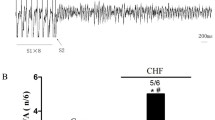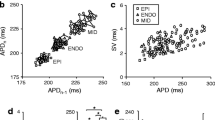Abstract
β-Adrenergic stimulation differentially modulates different K+ channels and thus fine-tunes cardiac action potential (AP) repolarization. However, it remains unclear how the proportion of I Ks, I Kr, and I K1 currents in the same cell would be altered by β-adrenergic stimulation, which would change the relative contribution of individual K+ current to the total repolarization reserve. In this study, we used an innovative AP-clamp sequential dissection technique to directly record the dynamic I Ks, I Kr, and I K1 currents during the AP in guinea pig ventricular myocytes under physiologically relevant conditions. Our data provide quantitative measures of the magnitude and time course of I Ks, I Kr, and I K1 currents in the same cell under its own steady-state AP, in a physiological milieu, and with preserved Ca2+ homeostasis. We found that isoproterenol treatment significantly enhanced I Ks, moderately increased I K1, but slightly decreased I Kr in a dose-dependent manner. The dominance pattern of the K+ currents was I Kr > I K1 > I Ks at the control condition, but reversed to I Kr < I K1 < I Ks following β-adrenergic stimulation. We systematically determined the changes in the relative contribution of I Ks, I Kr, and I K1 to cardiac repolarization during AP at different adrenergic states. In conclusion, the β-adrenergic stimulation fine-tunes the cardiac AP morphology by shifting the power of different K+ currents in a dose-dependent manner. This knowledge is important for designing antiarrhythmic drug strategies to treat hearts exposed to various sympathetic tones.





Similar content being viewed by others
References
Banyasz T, Horvath B, Jian Z, Izu LT, Chen-Izu Y (2011) Sequential dissection of multiple ionic currents in single cardiac myocytes under action potential-clamp. J Mol Cell Cardiol 50(3):578–581
Bers DM, Grandi E (2009) Calcium/calmodulin-dependent kinase II regulation of cardiac ion channels. J Cardiovasc Pharmacol 54(3):180–187. doi:10.1097/FJC.0b013e3181a25078
Chen-Izu Y, Chen L, Banyasz T, McCulle SL, Norton B, Scharf SM, Agarwal A, Patwardhan AR, Izu LT, Balke CW (2007) Hypertension-induced remodeling of cardiac excitation-contraction coupling in ventricular myocytes occurs prior to hypertrophy development. Am J Physiol Heart Circ Physiol 293:H3301–H3310
Chen-Izu Y, Izu LT, Nanasi PP, Banyasz T (2012) From action potential-clamp to “onion-peeling” technique—recording of ionic currents under physiological conditions. In: Kaneez FS (ed) Patch clamp technique. InTech. doi:10.5772/35284
Drici M-D, Arrighi I, Chouabe C, Mann JR, Lazdunski M, Romey G, Barhanin J (1998) Involvement of IsK-associated K+channel in heart rate control of repolarization in a murine engineered model of Jervell and Lange-Nielsen syndrome. Circ Res 83(1):95–102. doi:10.1161/01.res.83.1.95
Fauconnier J, Lacampagne A, Rauzier JM, Vassort G, Richard S (2005) Ca2 + −dependent reduction of IK1 in rat ventricular cells: a novel paradigm for arrhythmia in heart failure? Cardiovasc Res 68(2):204–212. doi:10.1016/j.cardiores.2005.05.024
Gadsby DC (1983) Beta-adrenoceptor agonists increase membrane K+conductance in cardiac Purkinje fibres. Nature 306(5944):691–693
Grandi E, Pasqualini FS, Pes C, Corsi C, Zaza A, Severi S (2009) Theoretical investigation of action potential duration dependence on extracellular Ca2+ in human cardiomyocytes. J Mol Cell Cardiol 46(3):332–342. doi:10.1016/j.yjmcc.2008.12.002
Grimm M, Brown JH (2010) Beta-adrenergic receptor signaling in the heart: role of CaMKII. J Mol Cell Cardiol 48(2):322–330. doi:10.1016/j.yjmcc.2009.10.016
Harmati G, Bányász T, Bárándi L, Szentandrássy N, Horváth B, Szabó G, Szentmiklósi JA, Szénási G, Nánási PP, Magyar J (2011) Effects of β-adrenoceptor stimulation on delayed rectifier K+ currents in canine ventricular cardiomyocytes. Br J Pharmacol 162(4):890–896. doi:10.1111/j.1476-5381.2010.01092.x
Heath BM, Terrar DA (2000) Protein kinase C enhances the rapidly activating delayed rectifier potassium current, IKr, through a reduction in C-type inactivation in guinea-pig ventricular myocytes. J Physiol 522(3):391–402. doi:10.1111/j.1469-7793.2000.t01-2-00391.x
Horvath B, Magyar J, Szentandrassy N, Birinyi P, Nanasi PP, Banyasz T (2006) Contribution of IKs to ventricular repolarization in canine myocytes. Pflugers Arch 452(6):698–706. doi:10.1007/s00424-006-0077-2
Karle CA, Zitron E, Zhang W, Kathofer S, Schoels W, Kiehn J (2002) Rapid component I(Kr) of the guinea-pig cardiac delayed rectifier K(+) current is inhibited by beta(1)-adrenoreceptor activation, via cAMP/protein kinase A-dependent pathways. Cardiovasc Res 53(2):355–362
Koumi S, Wasserstrom JA, Ten Eick RE (1995) Beta-adrenergic and cholinergic modulation of inward rectifier K+channel function and phosphorylation in guinea-pig ventricle. J Physiol 486(Pt 3):661–678
Lengyel C, Iost N, Virag L, Varro A, Lathrop DA, Papp JG (2001) Pharmacological block of the slow component of the outward delayed rectifier current (I(Ks)) fails to lengthen rabbit ventricular muscle QT(c) and action potential duration. Br J Pharmacol 132(1):101–110. doi:10.1038/sj.bjp.0703777
Lu Z, Kamiya K, Opthof T, Yasui K, Kodama I (2001) Density and kinetics of I(Kr) and I(Ks) in guinea pig and rabbit ventricular myocytes explain different efficacy of I(Ks) blockade at high heart rate in guinea pig and rabbit: implications for arrhythmogenesis in humans. Circulation 104(8):951–956
Marx SO, Kurokawa J, Reiken S, Motoike H, D’Armiento J, Marks AR, Kass RS (2002) Requirement of a macromolecular signaling complex for β adrenergic receptor modulation of the KCNQ1-KCNE1 potassium channel. Science 295(5554):496–499. doi:10.1126/science.1066843
Nakashima H, Gerlach U, Schmidt D, Nattel S (2004) In vivo electrophysiological effects of a selective slow delayed-rectifier potassium channel blocker in anesthetized dogs: potential insights into class III actions. Cardiovasc Res 61(4):705–714. doi:10.1016/j.cardiores.2003.12.016
Nitta J, Furukawa T, Marumo F, Sawanobori T, Hiraoka M (1994) Subcellular mechanism for Ca(2+)-dependent enhancement of delayed rectifier K+ current in isolated membrane patches of guinea pig ventricular myocytes. Circ Res 74(1):96–104
Noble D, Varghese A, Kohl P, Noble P (1998) Improved guinea-pig ventricular cell model incorporating a diadic space, IKr and IKs, and length- and tension-dependent processes. Can J Cardiol 14(1):123–134
Rocchetti M, Besana A, Gurrola GB, Possani LD, Zaza A (2001) Rate dependency of delayed rectifier currents during the guinea-pig ventricular action potential. J Physiol 534(3):721–732. doi:10.1111/j.1469-7793.2001.00721.x
Rocchetti M, Freli V, Perego V, Altomare C, Mostacciuolo G, Zaza A (2006) Rate dependency of β-adrenergic modulation of repolarizing currents in the guinea-pig ventricle. J Physiol 574(1):183–193. doi:10.1113/jphysiol.2006.105015
Sanguinetti MC, Jurkiewicz NK, Scott A, Siegl PK (1991) Isoproterenol antagonizes prolongation of refractory period by the class III antiarrhythmic agent E-4031 in guinea pig myocytes. Mechanism of action. Circ Res 68(1):77–84. doi:10.1161/01.res.68.1.77
Scherer D, Kiesecker C, Kulzer M, Gunth M, Scholz EP, Kathofer S, Thomas D, Maurer M, Kreuzer J, Bauer A, Katus HA, Karle CA, Zitron E (2007) Activation of inwardly rectifying Kir2.x potassium channels by beta 3-adrenoceptors is mediated via different signaling pathways with a predominant role of PKC for Kir2.1 and of PKA for Kir2.2. Naunyn Schmiedebergs Arch Pharmacol 375(5):311–322. doi:10.1007/s00210-007-0167-5
Thomas D, Kiehn J, Katus HA, Karle CA (2004) Adrenergic regulation of the rapid component of the cardiac delayed rectifier potassium current, I(Kr), and the underlying hERG ion channel. Basic Res Cardiol 99(4):279–287. doi:10.1007/s00395-004-0474-7
Tromba C, Cohen IS (1990) A novel action of isoproterenol to inactivate a cardiac K+ current is not blocked by beta and alpha adrenergic blockers. Biophys J 58(3):791–795. doi:10.1016/S0006-3495(90)82422-X
Varro A, Balati B, Iost N, Takacs J, Virag L, Lathrop DA, Csaba L, Talosi L, Papp JG (2000) The role of the delayed rectifier component IKs in dog ventricular muscle and Purkinje fibre repolarization. J Physiol 523(Pt 1):67–81
Volders PG, Stengl M, van Opstal JM, Gerlach U, Spatjens RL, Beekman JD, Sipido KR, Vos MA (2003) Probing the contribution of IKs to canine ventricular repolarization: key role for beta-adrenergic receptor stimulation. Circulation 107(21):2753–2760. doi:10.1161/01.CIR.0000068344.54010.B3
Wischmeyer E, Karschin A (1996) Receptor stimulation causes slow inhibition of IRK1 inwardly rectifying K+ channels by direct protein kinase A-mediated phosphorylation. Proc Natl Acad Sci U S A 93(12):5819–5823
Zaza A, Rocchetti M, Brioschi A, Cantadori A, Ferroni A (1998) Dynamic Ca2 + −induced inward rectification of K+ current during the ventricular action potential. Circ Res 82(9):947–956
Zeng J, Laurita KR, Rosenbaum DS, Rudy Y (1995) Two components of the delayed rectifier K+current in ventricular myocytes of the guinea pig type. Circ Res 77(1):140–152. doi:10.1161/01.res.77.1.140
Acknowledgments
We are grateful to Dr. Donald M. Bers for doing an internal review and editing of the manuscript. This work was supported by the National Institute of Health R01 grant (HL90880) to LTI, YC, and TB; the National Institute of Health R03 grant (AG031944) to YC; American Heart Association National Center Scientist Development Award (0335250 N) to YC; European Society of Cardiology Visiting Scientist Award to BH; the Hungarian Research Fund OTKA (K101196) to TB; and the startup funds from the University of California to LTI and YC.
Conflict of interest
None
Author information
Authors and Affiliations
Corresponding author
Additional information
Tamas Banyasz and Zhong Jian are the first authors with equal contribution.
Rights and permissions
About this article
Cite this article
Banyasz, T., Jian, Z., Horvath, B. et al. Beta-adrenergic stimulation reverses the I Kr–I Ks dominant pattern during cardiac action potential. Pflugers Arch - Eur J Physiol 466, 2067–2076 (2014). https://doi.org/10.1007/s00424-014-1465-7
Received:
Revised:
Accepted:
Published:
Issue Date:
DOI: https://doi.org/10.1007/s00424-014-1465-7




